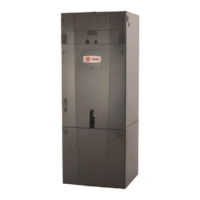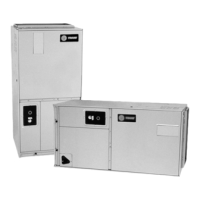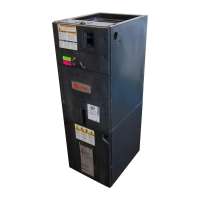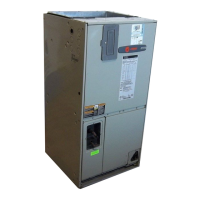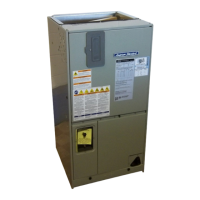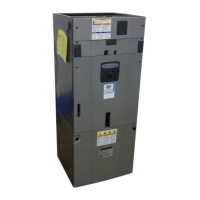BCX-SVX002A-EN
119
Table 42. BVCE coil general data (continued)
Unit Size 24 36 48 60 72 90 120
Nominal cfm 800 1200 1600 2000 2400 3000 4000
Wet coil weight - lb
N/A N/A N/A N/A 114.8 135.7 168.3
Internal volume - in
3
N/A N/A N/A N/A 649.8 811.3 999.5
(a)
Coil width = Length in the direction of a coil header, typically vertical.
(b)
Coil width = Length in the direction of a coil header, typically vertical.
(c)
The minimum waterflow at 1-1.5 fps tubeside velocity is to ensure the coil self-vents properly. There is no minimum waterflow limit for coils that do not require self venting.
See "Water Coil Piping" section for minimum self venting velocities.
(d)
Maximum gpm limits are to prevent erosion and noise problems.
(e)
DX coil height and width dimensions are same as comparable hydronic coils. Four- and six-row DX coil dry weight dimensions are same as comparable 4-row and 6-row
hydronic coils. A 3-row DX coil dry weight is 25% less than a comparable 4-row hydronic coil. Internal volumes are approximately 6% less than comparable hydronic coils.
Coils
All coils should be kept clean to maintain maximum
performance.
Water Coils
WARNING
Hazardous Voltage!
Failure to disconnect power before servicing could
result in death or serious injury.
Disconnect all electric power, including remote
disconnects before servicing. Follow proper lockout/
tagout procedures to ensure the power can not be
inadvertently energized. Verify that no power is
present with a voltmeter.
WARNING
Hazardous Chemicals!
Failure to follow this safety precaution could result in
death or serious injury. Coil cleaning agents can be
either acidic or highly alkaline and can burn severely
if contact with skin or eyes occurs.
Handle chemical carefully and avoid contact with
skin. ALWAYS wear Personal Protective Equipment
(PPE) including goggles or face shield, chemical
resistant gloves, boots, apron or suit as required. For
personal safety refer to the cleaning agent
manufacturer’s Materials Safety Data Sheet and follow
all recommended safe handling practices.
To clean water coils:
1. Disconnect all electrical power to the unit.
2. Wearing the appropriate personal protective
equipment, use a soft brush to remove loose debris
from both sides of the coil.
3. Install a block-off to prevent spray from going through
the coil and into a dry section of the unit and/or system
ductwork.
4. Mix a high-quality coil cleaning detergent with water
according to the manufacturer’s instructions.
Note: If the detergent is strongly alkaline after mixing
(PH 8.5 or higher), it must contain an inhibitor.
Follow the cleaning solution manufacturer’s
instructions regarding the use of the product.
5. Place the mixed solution in a garden pump-up sprayer
or high-pressure sprayer. If a high pressure sprayer is
to be used:
• Maintain minimum nozzle spray angle of
15 degrees.
• Spray perpendicular to the coil face.
• Keep the nozzle at least 6 inches from the coil.
• Do not exceed 600 psi.
6. Spray the leaving air side of the coil first, then the
entering air side.
7. Thoroughly rinse both sides of the coil and the drain
pan with cool, clean water.
8. Repeat steps 6 and 7 as necessary.
9. Straighten any coil fins that may have been damaged
during the cleaning process.
10. Confirm the drain line is open following the cleaning
process.
11. Allow the unit to dry thoroughly before putting it back
into service.
12. Replace all panels and parts and restore electrical
power to the unit.
13. Be careful any contaminated material does not contact
other areas of the unit or building. Properly dispose of
all contaminated materials.
Routine Maintenance
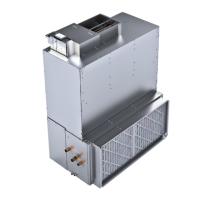
